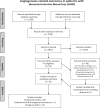Angiogenesis in abnormal uterine bleeding: a narrative review
- PMID: 36857162
- PMCID: PMC10320491
- DOI: 10.1093/humupd/dmad004
Angiogenesis in abnormal uterine bleeding: a narrative review
Abstract
Background: Abnormal uterine bleeding (AUB) has a significant socioeconomic impact since it considerably impacts quality of life. Therapeutic options are frequently based on trial and error and do not target disease aetiology. Pathophysiological insight in this disease is required for the development of novel treatment options. If no underlying cause is found for the AUB (e.g. fibroids, adenomyosis, polyps), endometrial-AUB (AUB-E) is usually caused by a primary endometrium disorder. When AUB is induced by prescribed (exogenous) hormones, it is classified as iatrogenic-AUB (AUB-I). Considering vascular modulation and function, AUB-E and AUB-I both could potentially result from abnormal vascularization in the endometrium due to alterations in the process of angiogenesis and vascular maturation.
Objective and rationale: We aim to investigate the fundamental role of angiogenesis and vascular maturation in patients with AUB and hypothesize that aberrant endometrial angiogenesis has an important role in the aetiology of both AUB-E and AUB-I, possibly through different mechanisms.
Search methods: A systematic literature search was performed until September 2021 in the Cochrane Library Databases, Embase, PubMed, and Web of Science, with search terms such as angiogenesis and abnormal uterine bleeding. Included studies reported on angiogenesis in the endometrium of premenopausal women with AUB-E or AUB-I. Case reports, letters, reviews, editorial articles, and studies on AUB with causes classified by the International Federation of Gynecology and Obstetrics as myometrial, oncological, or infectious, were excluded. Study quality was assessed by risk of bias, using the Cochrane tool and the Newcastle-Ottawa Scale.
Outcomes: Thirty-five out of 2158 articles were included. In patients with AUB-E, vascular endothelial growth factor A and its receptors (1 and 2), as well as the angiopoietin-1:angiopoietin-2 ratio and Tie-1, were significantly increased. Several studies reported on the differential expression of other pro- and antiangiogenic factors in patients with AUB-E, suggesting aberrant vascular maturation and impaired vessel integrity. Overall, endometrial microvessel density (MVD) was comparable in patients with AUB-E and controls. Interestingly, patients with AUB-I showed a higher MVD and higher expression of proangiogenic factors when compared to controls, in particular after short-term hormone exposure. This effect was gradually lost after longer-term exposure, while alterations in vessel maturation were observed after both short- and long-term exposures.
Wider implications: AUB-E and AUB-I are most likely associated with aberrant endometrial angiogenesis and impaired vessel maturation. This review supports existing evidence that increased proangiogenic and decreased antiangiogenic factors cause impaired vessel maturation, resulting in more fragile and permeable vessels. This matches our hypothesis and these mechanisms appear to play an important role in the pathophysiology of AUB-E and AUB-I. Exploring the alterations in angiogenesis in these patients could provide treatment targets for AUB.
Keywords: abnormal uterine bleeding; angiogenesis; angiogenic proteins; endometrium; hormone antagonists; hormone substitutes; hormones; metrorrhagia.
© The Author(s) 2023. Published by Oxford University Press on behalf of European Society of Human Reproduction and Embryology.
Conflict of interest statement
The authors report no conflict of interest.
Figures







References
-
- Abberton KM, Healy DL, Rogers PA.. Smooth muscle alpha actin and myosin heavy chain expression in the vascular smooth muscle cells surrounding human endometrial arterioles. Hum Reprod 1999a;14:3095–3100. - PubMed
-
- Abberton KM, Taylor NH, Healy DL, Rogers PA.. Vascular smooth muscle cell proliferation in arterioles of the human endometrium. Hum Reprod 1999b;14:1072–1079. - PubMed
-
- ACOG Committee on Practice Bulletins—Gynecology, American College of Obstetricians and Gynecologists. ACOG practice bulletin: management of anovulatory bleeding. Int J Gynaecol Obstet 2001;72:263–271. - PubMed
-
- Andersson E, Zetterberg E, Vedin I, Hultenby K, Palmblad J, Mints M.. Low pericyte coverage of endometrial microvessels in heavy menstrual bleeding correlates with the microvessel expression of VEGF-A. Int J Mol Med 2015;35:433–438. - PubMed
Publication types
MeSH terms
Substances
LinkOut - more resources
Full Text Sources
Medical
Miscellaneous

